M o d e l i n g xL a n g u a g e |
a xr e v i e w xo fx:
MG Taylor Method language |
part two of two
return to part one
|
| In Part One of this Paper, I set the context for the study and use of the Taylor Modeling Language and introduced a number of the models. In this second part, I will go deeper into the theory, practice and structure of the language. I will also outline some avenues for the future development of the language as there are many and they are much needed. Last, I will cover some of the antecedents to this approach and note the contributions that many have made to its development. |
| Language, it need not be pointed out, is both a social and individual tool. Its role in person-to-person communication is critical but the emphasis on this aspect of language often obscures its function as a tool of cognition. Language would still be important to a single individual living alone on an island. It is equally obvious, but often overlooked in the day-to-day living of life, that language embodies a social paradigm and is a great maker and holder of culture. Language also has technical aspects. Mathematics in this context is a language and perhaps the most universal we have with the exception of the visual arts and music. All disciples of every kind employ terms-of-art that have a district meaning within their craft. These are unique languages in their own right and often cut across the barriers created by different languages in the sense of English, French, Chinese and so on. It can be rightfully said that scientists, during the Cold War, often had more in common with each other than with their own countrymen within the Communist or Capitalist countries. Certainly, art reaches across culture and time and taps the universal to be found in us all. Most importantly, language is a structure. Each one sees some things uniquely and obscures other understandings. The reciprocal relationship between language, cognition and perception is too often brushed over as if intellect is some pure disembodied phenomenon. This can be dangerous stuff for the conclusions to be drawn from such dichotomies can lead to serious, negative consequences. |
| It has long been a dream of Humankind to discover a language that is universal in its ability to be understood and its capacity to bring the various languages of both race and disciplines into an integrated whole. I have chased this elusive will-of-the-wisp for much of my life. Different cultures bring the richness of different experiences and they establish a basis for serendipity and synergy in the conduct of human affairs. They also create profound and often dangerous barriers to understanding and common effort. |
| All of these considerations are at the heart of the Taylor Modeling Language. This seems like a large burden to impose on so modest an achievement but there it is. This effort is a beginning. It has a long development path ahead of it. It is but one aspect of the Glass Bead Game ideal. Nevertheless, even in its present immature form, it is a powerful tool for betterment if diligently applied to its designated field of application. |
|
...Playing With the Language |
| The creative process is adult play in its highest form. One of the Taylor Axioms “if you cannot have fun with a problem you will never solve it” points to this reality. If you cannot have fun with the Glyphs, they will remain meaningless and dead for you. When you can create a pun with the glyphical language you are on your way to mastery [link: learning mastery]. |
| All forms of language are intimate to your creative process. Creativity is a curious dance between following rules and breaking them. The “play” happens in the knife edge between the two. Arthur Koestler related humor to creativity. He said that we laughed when the totally logical collided with the totally unexpected. |
 This is INSIGHT (Synthesis) on the Creative Process Model - the moment when all the confusion clears and the idea is revealed. This is usually experienced as a great high - and often laughter and almost always relief and satisfaction. Insight is usually the result of the (often sudden) collapse of an existing mental construct be it a design assumption, that turns out to be wrong or not useful, a habit or entrenched belief that has worn out its welcome or an entire paradigm of thought. The is what makes the shock of both loss and recognition so intense. This is INSIGHT (Synthesis) on the Creative Process Model - the moment when all the confusion clears and the idea is revealed. This is usually experienced as a great high - and often laughter and almost always relief and satisfaction. Insight is usually the result of the (often sudden) collapse of an existing mental construct be it a design assumption, that turns out to be wrong or not useful, a habit or entrenched belief that has worn out its welcome or an entire paradigm of thought. The is what makes the shock of both loss and recognition so intense. |
| This stage of creativity has to be most carefully set up and facilitated be it a single individual conducting his/her own process or a team or a large group in a formal collaborative exercise. This is a death and rebirth experience. It is often resisted out of fear or ignorance. Like all of the Glyphs, each is a depository of knowledge, ideas and techniques to deal with the circumstance that they reference. This knowledge resides in the system and method of this work and also in the community of people who do the work [link: the 5 es of education]. |
|
| The glyphs are the words of the Method. They are a special kind of word. They are terms-of-art. This is to say they have an exact meaning intrinsic to the system of work. The meaning may vary a bit from community to community of users. Yet, it is critical that within each community that there be a high level of common use. This rigor facilitates the making of a common experience, a body of knowledge and a practice with continuity of effort. This is what a language, at its highest level of practice does. It also is a significant aspect of making a culture. No idea, or tool, is neutral in the philosophical sense. This language also has a bias. In this case it is a designed, deliberate attribute. The bias is towards creativity, collaboration and systemic wholeness. This language describes this kind of world. The glyphs embody these ideas. Think of them as energy centers - as talismans of a way of being and working in the japanese meaning of dogu. As such, they are expressions of practical magic. |
| Each of the glyphs belong to one or more models. As such they bring the full context of their model(s) to their use. If I were to say: |
| |
|
| anticipate (the) body of knowledge (necessaty to) design (whatever the subject is), I bring the full meaning of the Appropriate Response, 7 Domains, and Design Formation models to the actions necessay to be taken for success in a process or project. |
|
|
| |
 |
|
| |
 |
|
What does it mean to anticipate the body-of-knowledge necessary to support a design process? What does anticipate mean in context of the Appropriate response Model? What is a body-of-knowledge and what does that mean in the context of the 7 Domains? What is design and what does this mean in context of Design Formation?
|
| The use of the design glyph, in this model, pertains to Design Development which is a specific level of expression an idea takes along its path from idea to manifest reality. Design development is the detailing and engineering phase of a work. The criteria for knowledge is correspondingly more demanding and exact than in the earlier steps of the Solution Box [link: solution box architecture]. To anticipate this level and kind of knowledge may require action significantly ahead of the time it is required. An organization’s Body of Knowledge keeps its integrity and viability if facilitated by the 10 Step Process [link: 10 step process]. If not, it is only an philosophical abstraction - a metaphor with no practical reality. To a community of work, endowed with a common language, these glyphs say a great deal about the work ahead and its proper conduct. This goes much further and deeper than “we have to think about what we need to know before we can advance with the design.” A team made up of members who have worked together for a long period of time does get to a point of understanding what this previous sentence means. There are three issues, however: first, this takes a long time by trial and error; second, when a new circumstance comes up the “code” in the sentence is likely not to have adaptability and mobility; and, when a member of the team leaves, and or new members join, the process of aligning concepts and their meaning starts at least partially over - sometimes entirely over. |
| |
|
| There are many ways to employ the models and below I will show and describe a few of them. The first are four pages from my Future Views Notebooks which I made between October 2 and 7, 2006 in preparation and follow up for a World Economic Forum method transfer session held at the Ales Groupe in Milan. These notes range from the design of the event, to content I wished to present at it, to specifications for the November designShop® session in Geneva the focus of which is the use of the Davos WorkSpace at the 2007 Annual Meeting. Thus, this is a “classic” use of the models. This article, as I have noted, was stimulated by this event as a consequence of my growing understanding of the gap which exists, for many new users and those practicing of the Method, between their prior experience and the minimum Body of Knowledge required to start the learning-using process. In other words, familiarity of the basic language of the Method. Traditionally, people have learned by doubling up with experienced KnowledgeWorkers while doing a series of many DesignShops - as many as 20 to 40 in a year - and then, starting the study of the language and theory behind the work. As use of the Method has spread to new venues, the ability to start this way this is not always the case. In some circumstances it may never be the case. This presents a serious challenge to a craft which is best learned by doing and then by intellectual pursuit. |
This session did not go well as the gap was far greater than we expected and the preparation far less. Nevertheless, it lead to significant insight and a result that will most likely serve the November session well. It the end, a foothold was established that began a useful process of learning. The content that I had selected for the event, and that has been further developed on these pages, was on target. What we all discovered was missing was a basic description of, in this case, the Davos WorkPlace and how it operates. Only one person with this prior experience was in attendance. Numerous pictures, web links and documentations had not been made available to the new participants and the material which had was not fully employed - mostly, because it did not make sense out of context. There simply was no good place to begin (a point noted in my Notebook - but underestimated - prior to the event). All of this was due to a change in organization coupled with an expanded effort - both a very good thing - which brought many new people to the enterprise. It was a great case of “a situation demonstrating its own thesis” and after humor was recovered - just barely - we went on. Some day, not doubt, we will all be able to laugh about it. It was a rough start - but a start and we are over the Catch 22. There was pain involved for all and this will only be paid back if we are able to produce an outstanding 07 experience at Davos.
| [November 2009 note: both the DesignShop® and the Davos sessions were great advancements and set the foundation for the WorkSpace as it functions today] |
|
| This experience was the result of the boundary conditions being broken. It was the process before the event that was not properly conducted. Time ruled, not process. This is one of the hidden and most difficult aspects of the method to manage [link: zone of emergence model]. |
|
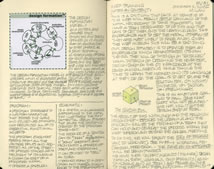 |
There are several aspects of this way of working illustrated by these pages.
First, in this case, the Models were both employed for process design and content. The pages, while hand notebook material - SKETCH on the Design Formation Model - are published by me and used with associates and clients, as well as serving as documentation of my work and life. This both rests on a common understanding of the Solution Box but also illustrates and promotes this use of the language. It demonstrates the RE-USE aspect of Strong Memory. This creates a Strange-Loop as discussed in Godel Esher Bach [rdtf book].
The Models with the hand style of the Notebooks create, together, a visual language that conveys content in a way different that the polished printed word. Modern sophistication tends to obscure the nuance associated with different graphic-presentation styles.
Of course, the participants were given the same Moleskin® Notebooks and a set of the Models with sticky backs, thus, invited to employ the same tactile-thinking process which I used - a form of recursion and the 5Es of Education [link].
click on graphics for screen size images |
|
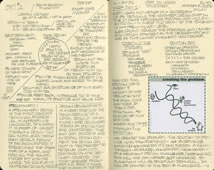 |
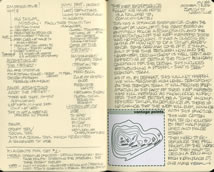 |
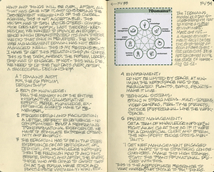 |
for the November DesignShop the following four pages were produced: |
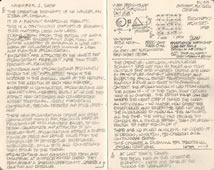 |
The work on these pages started with a focus on the WEF DesignShop design and soon, as is usual, started to explore an issue of a more general nature but one triggered by the two almost back to back WEF experiences.
It can be noted that this Paper, and many other pages that link to it, was being written during the same period. So I was both using, for design and facilitation purposes, the language while teaching it, documenting its use and writing about the basis of the language.
This is how, of course, a language is developed - by use.
The new issue that started on p. FV38 is a Weak Signal question: what are the factors that is seemingly making this work more difficult to deliver at the moment that the general idea of it is coming into broad acceptance? And, once this is understood, what is the appropriate response to the new condition? I point this out to show - once again - the close correlation between the theory, practice and the business of the work and how each informs the other in real time. I did not resolve these questions but they are documented in context of the conditions and time in which they were raised.
click on graphics for screen size images |
|
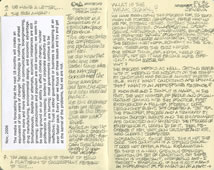 |
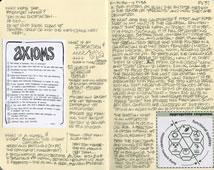 |
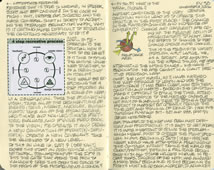 |
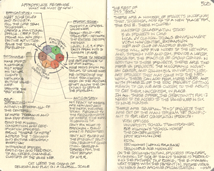 |
Notebook #7, of my Post 9/11 Series documents the story of the making of the Davos WorkSpace, the 2005 use of it and the follow on to 2006. Page 508 - left - itself, is an exemplifies use of the Modeling Language.
click on the graphic for INDEX |
|
| Other uses of the Modeling Language - by the way, we call it modeling language because we consider words, and models, to be a slice of reality [link; slice of reality] - no one way of looking at reality or naming it can be comprehensive. Many ways, integrated, can improve the resolution. Every language - of any kind and variant within a kind - illuminates some facets of realty better then others and other aspects less so. Every one blinds us to whole realms of reality and the full potential for life. All have bias. Objectivity, in this context, is knowing this, being aware of the benefits and blind spots of one’s concepts - and ways of expressing them - and acting with integrity by careful testing and the employment of true feedback. |
|
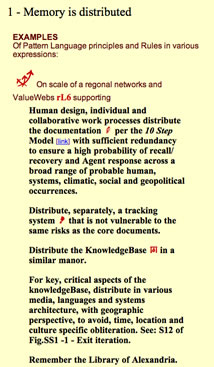 |
This Method Language example is from my web site. It is used to supplement one example describing distributed memory - one of the 22 aspects of Strong Memory.
Four glyphs - process, documentation, tracking and knowledge base act as terms-of-art. The Ten Step Model and a patent diagram are used to precisely describe and specify the process being described.
The 7 Domains Model is referenced by two of the glyphs. The level of recursion - rL6 - of the system in focus is also identified - this is rarely done creating great ambiguity.
This example is one of a myriad on how to apply the principle of distributed memory in the design of a system. |
|
click on the graphic to go
to this example |
| It is important to understand that mere precision is not the only goal. Terms-of-art are important yet language has other valuable attributes. Nuance is important. Multiple meanings and unexpected connections are important, What some people mistakenly call imprecision is as important as precise meanings. A “looser” language is useful during the first half of the Creative Process Model, a “stricter” language for the second. |
| The Glyphs are carefully constructed from etymology (the word part) and symbolic language (the icon part) so as to reference many social, cultural, historical meanings [link: explore modeling language]. Great richness can be brought to a dialog and integrated with the precise engineering level meaning of the glyph. Thus, the Glyphs dialog with themselves just as we can enrich our dialog by using them. |
|
|
While I show the Modeling Language on the fourth level of the seven that makes up the system, the intention is that the Modeling Language - being the most “invented” other than algorithm - ties all of these levels together.
The Modeling Language is not a complete language in itself. It is a language designed to augment existing verbal (word), kinesthetic (posture and gesture) and visual (form and color) languages into a meta-system of thought and communication. See if you can find the subtle message in the graphic.
click on the graphic to go
to the full Table 1 |
|
| Each Glyph carries with it many meanings: its word, its symbol, its cultural connotation, historical reference and the context of the model(s) within which it is housed. In Addition, a community-of-work will build up their own additional meanings based on their experience of the Method and doing the work. |
|
...Practicing the Language |
| No language can be properly learned in the abstract. It has to be practiced - and, this means practiced in the culture it represents, reinforces and partially helps create. The Modeling Language is no different. There is another aspect to practicing in addition to learning something as it is - this is the aspect of improving it through use. To practice has multiple meanings and it is in the most fulsome sense that I use the term here. When one refers to a practice of architecture, a law practice or the work of a master craftsman, it is usually encompasses this more robust meaning. Advancing-the-art is a defining aspect of a practice and true knowledge-work as Peter Drucker defined it. |
Throughout the network of Taylor Method users, a small minority are conversant with, and use, the Language anywhere near its present capacity let alone anywhere near its potential. The Method was designed so that the participants of events can be successful without knowing the process at all. It was designed so that those who provide events can become proficient by working on the first three levels of language: descriptive, technical and pattern language only as shown on the graphic above. The descriptive level describes the philosophy and practice of the Method in everyday, common-usage language. The technical, establishes the essential terms-of-art necessary to frame the experience of doing the work. Pattern Language must be identified (at lease on levels one and two) and experienced by doing the work in an iterative manner over an extended time period. These three levels and a good sense of design satisfies necessity. ART requires understanding and applying the Modeling Language throughout the entire range and scope of the Method’s practice. No practice of this method nor any NavCenter (in all variants) has ever sustained without this level of Art being represented in ownership, management and on the level of product-service delivery.
|
| The Modeling language will not reach its full potential until it is fully practiced - used and developed - by a ValueWeb of KnowledgeWorkers. |
| For the MG Taylor mission [link: mg taylor mission] to be accomplished and Xanadu [link: xanadu project] to become a hub in a network of global capability, a critical mass of physical place, knowledge-base, knowledge-worker users and worthy projects [link:worthy problems] will be required. This is on the order of magnitude of three to four times greater than now. This will produce a community of serious language users of about one to two thousand - enough to start building a true language; enough to create a future by design, not default [link:a future by], enough to build a platform for all life [link:a testament]. |
|
...Further Development of the Language |
To be anywhere near a functional language, the Modeling Language will have to grow five to ten times in terms of its present number of “words”(glyphs), “paragraphs” (models) and “books” (PatchWorks of Models).
|
| Boolean Logic symbols [link: a boolean logic primer] can be used and other math symbols-operations as “words;” greater than, less than, the sum of, etc. Specific terms-of-art can be put in abbreviated form: rbtf (rebuilding the future), tap (take-a-panel) and so on. Flow charting symbols can be assigned meaning or categories and different line and arrow types the same. Also colors can have meaning. By these simple means the language can be extended. Hypertext documents can be organized so that there are “layers” of information and the layers (recursion levels) themselves can have specific meaning (such as the 7 levels of manifestation in form represented by the design Formation Model). The objective is to pack as much content (both denotation and connotation) into the smallest space so that the eye-mind can grasp it whole - as a meta-concept - and then go into the many meanings and relationship as required. We use all these methods now in Andmap® diagrams and other tools. |
| Each community of work can make up their own symbols and words to make their language both more precise and loaded with meaning. Remember, we are talking about design, innovation and systemic thinking here not just the far more simple task of the transmission of known, codified social knowledge. Both rigor and ambiguity have to be present, together, to stimulate the shift-in-mind necessary to facilitate real breakthrough. A language capable of being both, simultaneously, is valuable in this regard. Thinking and designing are as much physical an experience as mountain climbing [Link: fllw and unity temple]. It is just that we have created such impoverished environments, in which we expect people to learn and create, that we have come to think of mental activities in such a disembodied sense. The 7 Domains Model describes the scope and range necessary to consider, create and produce an environment conducive to human creativity. I talked about hypertext links in the above paragraph. If you do not go to the Frank Lloyd Quote about designing the Unity Temple (above), read it and my summary below it, it could be you will not “take” this paragraph in the way that I mean it. Our society is used to treating information as linear. Of course it is not. Our mind parallel processes all the time. Most of this process and the “system which makes it happen, we simply are not aware of. Information has to be “stacked” in order to be more mind-like. |
Many people who read my web site say “I can never get through any part of it the same way twice. Some like this and some not.
|
The left hand frame on my site is intended to set a context for the content of the site and to offer guidance for how the material is intended to be taken and used.
Notice the glyph. It is the tug and pull in the creative act of bringing vision to everyday life and conditions.
This statement is a warning about the prevalent habit of disconnecting information from the context in which it was created and is presented. It stakes the claim that I have chosen a different path: synthesis, integration, integrity - holding history while advancing it.
It takes a stand against the “cult of efficiency” a production and economic principle our times have taken way out of context and drive way too far down the road to self destruction.
Can everything be connected to everything? Well, it is. This is generally ignored. The ability to connect and act accordingly is a measure of intelligence. The ability to connect and make useful new connections is a measure of creativity. To both in a way useful to a time and a society is a measure of innovation. To do this without causing harm is a measure of wisdom. |
|
 |
| I, of course, say “exactly!” I do not want you to get through it the same way twice. This is not a data base nor is a about information. It is about playing with new ideas and fostering emergent thinking. This is my story but it is not about me. The subject is what you do because you have read this material” This position is at the heart of how I see learning and knowledge “transfer.” I want my readers to “hunt.” to be a hunter gatherer which requires local knowledge and great alertness. This is what we have the hunter gatherer Module in DesignShops. Information you find by your own search is different than the “same” information that is handed to you. The form of a message has content in itself. |
We have built a glyph font. I do not use this on many of my web-pages because not all browsers, yet, can deal with the font. This article would have benefited form this usage. The memory [link: 22 aspects of memory] article does use the gylph fonts and you can download them from this article. Microsoft Explorer will display the fonts if you put them in your font folder. If you do so,
Can you read this
will take on an entirely different form. It might also be interesting to think about what this series of glyphs might be “saying” about this paragraph. |
| It is clear that the Modeling language is intended to be a multimedia language. This provides access to the many kinds of intelligence types. Everyone has them all and each in their own unique mix. Word-only languages tend to be narrow in this regard and exclude a large percentage of the population. I am working on an art form I call Abscapes™ which is a way of extending this approach to make a blend of art, symbol and content. To date, I have only developed a bit of the theory and done some insignificant sketches. A full work, that will exercise the full range of the concept, is still in the future. Click on the graphic below to explore this nascent discipline. On the Solution Box Model I am at |
Planetary
Architecture
2005 |
|
There are so many antecedents to the Modeling language that several books would not begin to scratch the surface. The fist and foremost is language itself. All words are a sound/symbol that is an abstraction that “holds ” a tremendous amount of experience and has universal meaning and unique nuance to specific cultures and individuals. If I say “I love green chairs,” the amount of information potential in these four word is tremendous. What do I experience and mean when I say “I?” What is the concept “love” and what is the essence of it when I refer to such a personal emotional state? And “green?” here is a denotative concept of many shades with a broad universal reference. Do I prefer different greens? Can I see the many ranges of green? Do I attach specific memories (regenerations, actually) to the color green? Can I feel green - smell it? The sentence I choose to illustrate my concept is efficient and most - in this case - English speaking people would have little difficulty in understanding my meaning. But how much of it would they grasp? How much of the true meaning - to them - of what I said would be the consequence of their own experience and cognition? |
| Mathematics is a language and so it music. This is not all they are but they certainly function as language. And then there is sign language, Pattern language, art, architecture. The list goes on. Language does more than facilitate communication. It is a tool of thinking. It can have layers of meaning like the Cabala. It can be symbolic - that is symbols on top of, imbedded in, or pointing to symbols. Then there is the dream of The Glass Bead Game [rdtf book]. |
| Many Books like the Foundation Series, Glass Bead Game, Man and his symbols, as well as 5,000 years of esoteric symbolism in architecture, philosophy and texts has composed the cultural environment out of which this language has sprouted. Use and further cultivation will result in a garden the fruit of which will enable us to see, communicate, think and design with concepts more closely aligned with the true nature of human creativity and collaboration. |
| It should be clear that the MG Taylor environments are more than convenient, flexible places to work. Their art is an embedded language which is conversant with the processes which take place within the environment. It is the aspect of the environment’s function as language which has a deep, powerful effect on the quality, efficacy and volume of the work performed [link: 20 years of mg taylor environments]. |
|
| This Paper is an introduction. There is a great deal more, to the common practice of this Method, than I have described here. Over 25 years of work makes a large experience-base to document. Yet, this Paper is a good beginning. It and the references and links provided in it, are actually enough for someone to go a long way on the path of understanding and creative application of this philosophy and way of working. It can be credibly said, that to provide more before personal learning and some experience from application, is actually counterproductive. |
|
|
| Return: MG Taylor Modeling Language 1 |
|
|
|
|
| GoTo: INDEX - Matt Taylor Papers 2006 |
|
|
|
|
| GoTo: Solution Box Architecture |
|
|
|
Matt Taylor
Nashville
October 10, 2006
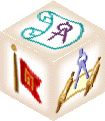
SolutionBox
voice of this document:
ENGINEER • STRATEGY • CONSTRUCTION DOCUMENT
|
posted:
October 10, 2006
revised:
Novenber 19, 2009
• 20061010.651930.mt • 20061012.453100.mt •
• 20061014.341000.mt • 20061015.812516.mt •
• 20061030.623762.mt • 20061115.767650.mt •
• 20091119.162091.mt •
(note:
this document is about 95% finished)
Copyright© Matt
Taylor 1979, 1981, 1982, 1998, 2001, 2006, 2009 |
|
|